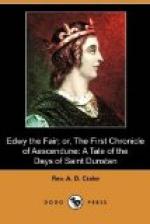xii Psalm xxi. 3.
xiii “All were indignant at the shameless deed, and murmured amongst themselves,”—William of Malmesbury.
xiv The Welsh were driven from Exeter by King Athelstane; before that time, Englishmen and Welsh had inhabited it with equal rights.
xv The earliest inhabitants of Ireland were called Scots.
xvi Legends about St. Dunstan.
“It is a great pity,” says Mr. Freeman, in his valuable “Old English History,” “that so many strange stories are told about him [Dunstan], because people are apt to think of those stories and not of his real actions.” This has indeed been the case to such an extent that his talents, as a statesman and as an ecclesiastical legislator, are almost unknown to many who are very familiar with the story of his seizing the devil by the nose with a pair of tongs. Sir Francis Palgrave supposes that St. Dunstan’s seclusion at the time had led him to believe, like so many solitaries, that he was attacked in person by the fiend, and that he related his visions, which were accepted as absolute facts by his credulous hearers. Hence the author has assumed the currency of some of these marvellous legends in his tale, and has introduced a later one into the text of the present chapter. But the whole life of the saint, as related by his monkish biographers, is literally full of such legends, some terrible, some ludicrous. One of the most remarkable deserves mention, bearing, as it does, upon our tale. It is said that he learned that Edwy was dead, and that the devils were about to carry off his soul in triumph, when, falling to fervent prayer, he obtained his release. A most curious colloquy between the abbot and the devils on this subject may be found in Osberne’s “Life of Dunstan.”
xvii The Benedictine Rule.
St. Benedict, the founder of the great Benedictine Order, was born in the neighbourhood of Nursia, a city of Italy, about A.D. 480. Sent to study at Rome, he was shocked at the vices of his fellow students, ran away from the city, and shut himself up in a hermitage, where he resigned himself to a life of the strictest austerity. Three years he spent in a cave near Subiaco, about forty miles from Rome, where he was so removed from society that he lost all account of time. He did not, however, lead an idle life of self contemplation; he instructed the shepherds of he neighbourhood, and such were the results of his instruction that his fame spread widely, until, the abbot of a neighbouring monastery dying, the brethren almost compelled him to become their superior, but, not liking the reforms he introduced, subsequently endeavoured to poison him, whereupon he returned to his cave, where, as St. Gregory says, “he dwelt with himself” and became more celebrated than ever. After this the number of his disciples increased so greatly, that, emerging from his solitude, he built twelve monasteries, in each of which he placed twelve monks under a superior, finally laying the foundation of the great monastery of Monte Cassino, which has ever since been regarded as the central institution of the order.




